Application of dry waterproofing
In finished form, only coating waterproofing mastics are produced, other types must be kneaded independently. Each composition has its own instructions for preparation and use. General rules are presented in the following table:
| 1) Mix the dry mixture with a special liquid (depending on the composition - with water) until a homogeneous mass is obtained. First, pour the dry mixture into the container where the solution will be prepared, and only then add water in portions, stirring vigorously. The mass should be as homogeneous as possible and without lumps. After keeping the solution for 3 - 5 minutes, mix again. Use the mixture within 60 minutes of preparation. | |
| 2) Using a synthetic brush, apply the prepared mixture in a thin layer on a damp but not wet substrate. It is best to work with solutions at room temperatures from + 15 ° C to + 23 ° C. When preparing a new portion, you should thoroughly wash the container from the remains of the old one. | |
| 3) Seal all joints between building structures (walls and floors). To do this, round off the inner corners with a mortar mixture of a thicker consistency with a radius of at least 3 cm. | |
| 4) Stick the sealing tape at the joints of the walls and floor. Apply a second coat of the mixture on top. | |
| 5) After 72 hours, you can start facing work. | |
| 6) After tiling, grout and seal joints and corners with flexible silicone sealant to prevent mold and mildew. |
Whichever type of waterproofing with dry mixes is chosen, it should be remembered that careful adherence to technology is the key to the quality of the coating. Therefore, before starting work, be sure to read the manufacturer's recommendations for applying a protective water-repellent layer in a particular case.
TECHNICAL CHARACTERISTICS OF WATERPROOFING CERESIT CR 166:
| Composition of component A | mixture of cement, mineral fillers and polymer modifiers |
| Composition of component B | aqueous polymer dispersion |
| Bulk density of dry mix (component A): | 1.3 ± 0.1 kg / dm 3 |
| Density of polymer dispersion (component B): | 1.03 ± 0.105 kg / dm 3 |
| Component ratio: | A: B = 2.4: 1 by mass |
| Density of the ready-to-use mixture: | 1.7 ± 0.1 kg / dm 3 |
| Consumption time: | at least 1 hour |
| Application temperature: | from +5 to +30 С |
| Waterproof: | not less than 0.6 MPa |
| Crack bridging ability: | not less than 0.75 mm |
| Adhesion to concrete at the age of 28 days: | not less than 0.8 MPa |
| Rain resistance: | after 3 days |
| Ready for fixing tiled facings: | after 3 days |
| Hydraulic readiness: | after 7 days |
Varieties in composition
When choosing, take into account the type of components, the structure of the mixture. The material is selected taking into account the intended purpose of the enclosed structure, operating conditions. Waterproofing must correspond to the temperature regime at which it will be applied and served in the future. Violation of this condition will lead to the gradual destruction of the protective layer.
Cement-sand waterproofing
The composition is available in the form of a dry mixture. This is the simplest type of waterproofing in terms of properties, which is due to the use of cement as the main component. The mixture is quite tough; during the drying process, the protective coating should be moistened frequently - up to 3 times a day for 2 weeks.
For application, it is recommended to use the spray method of the composition using special equipment. The main purpose of the cement-sand mixture is to protect the monolithic foundation of objects.If you plan to apply waterproofing yourself, to increase the density of the composition, you need to introduce special additives. Without them, the life of the waterproofing will be reduced, and the coating will not perform its functions.
The mixture is applied sequentially several times. When the work is over, it is recommended to protect the fenced structure from possible damage during drying.
However, the surface of the waterproofing layer can still deform. In this case, moisture evaporates unevenly, which leads to a change in volume with different intensities.
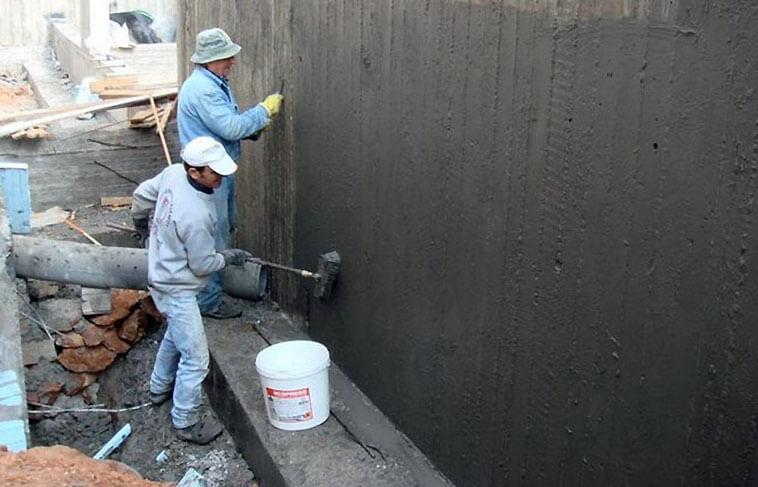
With the addition of latex
Due to this composition, the plasticity of the material is ensured. Latex increases the resistance of the waterproofing to cracking. The material tolerates the effects of temperature extremes and low values of this parameter much better. As a result, the cement mixture resembles liquid rubber in appearance and properties. After applying the material, an impermeable coating is obtained, which reliably protects the enclosed structure from moisture.
You can add latex to the cement mixture yourself, keeping the proportions. However, it is much easier to use a ready-made mixture.
Mandatory conditions when working with such material:
- application of the method of shotcrete or spraying on a surface that has been carefully prepared beforehand;
- the mixture should be hot.
As a result, a seamless coating is obtained that does not allow moisture to pass through, does not crack, is resistant to mechanical stress and lasts a long time, and also withstands exposure to high temperatures.
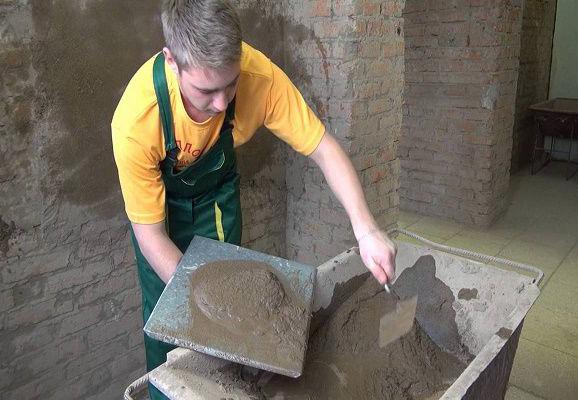
With liquid glass
Such a component is added to the cement mixture, which improves the properties of a hard cement-sand mortar. Most often, the material is used to protect the foundation, basement floors, and to form refractory coatings.
Advantages of formulations based on liquid glass:
- protection against high temperatures;
- high adhesion;
- manifestation of antiseptic properties;
- lack of toxic components in the composition.
Various uses:
- liquid glass is applied to seams, joints, cracks, this option is used as an auxiliary measure, after applying this type of waterproofing, roll material is also used;
- liquid glass is used as the main component of a cement mixture intended for pouring a foundation.
Cement-polymer
The composition includes Portland cement, sand, plasticizers. Cement-polymer waterproofing has improved properties. The main advantage of such a material is considered to be high resistance to tensile and tensile loads. This is due to the formation of molecular bonds with the combination of polymer components and cement. As a result, the enclosed structure tolerates dynamic loads well and is resistant to cracking.
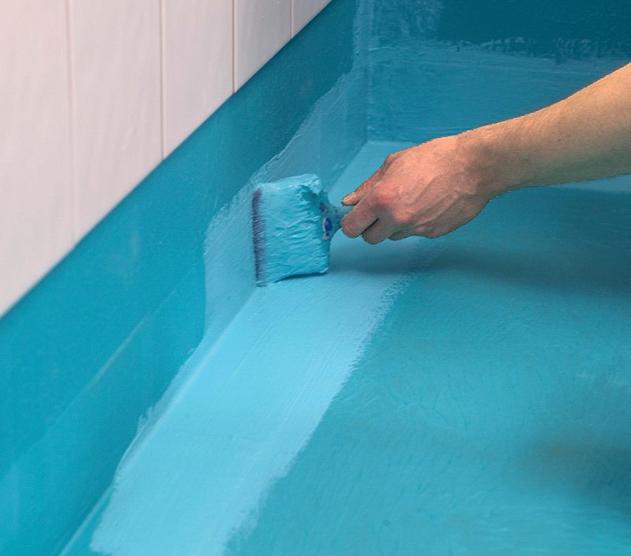
There are different types of polymer-cement mixtures:
- waterproofing adhesive;
- waterproofing.
There are one- and two-component formulations. Moreover, the second of the options is more common. It contains acrylic emulsion, microfiber. This material is used when there is a high risk of deformation loads (cracks of more than 1 mm are formed). In other cases, you can use dry one-component mixtures.
Penetrating waterproofing
The ideal solution can be penetrating mixtures for waterproofing, which can easily and quickly penetrate deep into the pores of building elements. After drying, they reliably protect the entire cavity from the damaging effects of moisture. Dry mortars with a cement composition for the floor simply penetrate the pores and clog them. They are usually applied from both the inner and outer surfaces.
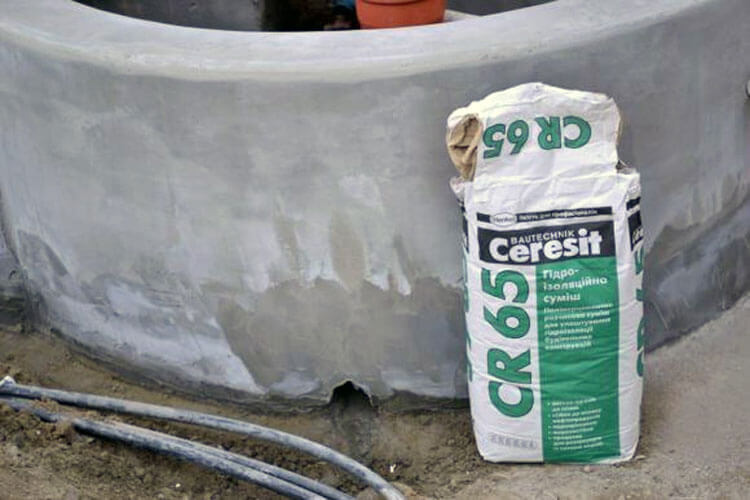
Waterproofing mixture Ceresit
There are mixtures of a penetrating composition, injection and capillary:
- Cement-based dry waterproofing capillary mass is designed for horizontal finishing, i.e.for walls. The materials are applied to the outside and penetrate deep into the middle. The service life of the treated surface is unlimited.
- Injectable dry mixes are designed for the restoration of concrete elements, floors, foundations, etc. Existing cracks and damage are reliably protected from water ingress.
Types of mixtures for waterproofing works
Dry waterproofing mixtures of this category provide excellent water resistance of concrete structures, they can be used both at the initial stage of construction and in the repair or restoration of building structures.
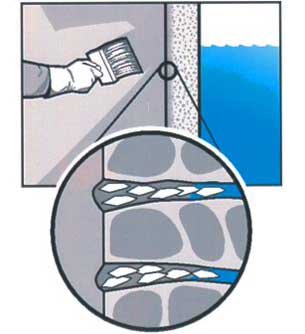
Penetrating waterproofing
Waterproofing mixtures of this group are intended for volumetric waterproofing of porous waterproof material.
The principle of operation is as follows:
- penetration of the solution into the porous structure of the insulated material;
- fixation of the material in the capillary pores of concrete in the form of chemical compounds that do not dissolve;
- filling of pores with hardly soluble crystals.
The principle of action of mixtures of penetrating waterproofing
The penetrating waterproofing mixture, which includes special components, allows additional modification of the qualities of the processed material:
- restoration of the technical properties of the "old" concrete "coating;
- prevention of corrosion in reinforcement of reinforced concrete base;
- increasing the chemical resistance of the insulated material;
- elimination of fungal formations and mold.
A mixture for waterproofing penetrating action is used on such objects:
- different tanks;
- waterproofing of swimming pools;
- mines and tunnels;
- dams and foundations;
- pumping stations;
- hydraulic engineering and treatment facilities;
- production premises;
- buried premises, etc.
The range of mixtures on the construction market is huge, the following materials can be distinguished:
materials of the Lakhta system - dry mixes on a cement basis, which are used for waterproofing foundations and culverts;
Dry mix
materials of the Stromix system - high chemical resistance and strength characteristics allow using these mixtures for repair and restoration waterproofing works of varying degrees of complexity;
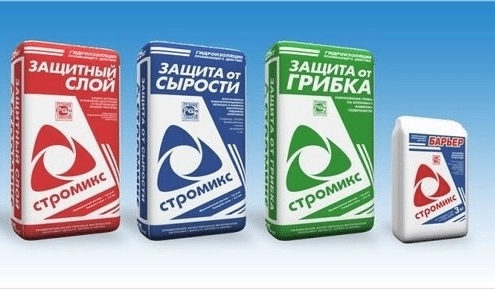
Waterproofing Stromix
materials of the Kalmatron system - building mixtures that are good protection of reinforced concrete and other porous building materials from the influence of an aggressive environment of a different nature.
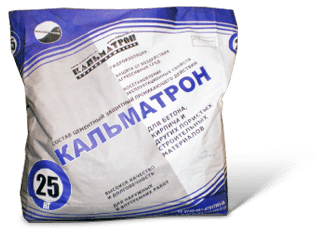
Waterproofing Kalmatron
Waterproofing dry mixes of this category are designed to protect the surface from water using a high-strength waterproof layer.
These materials are used in the manufacture of waterproof high-strength reinforced concrete and concrete structures, as well as protective reinforced layers, which are designed for a long service life and have the following characteristics:
- uniformity;
- high strength structure;
- maximum water resistance;
- frost resistance.
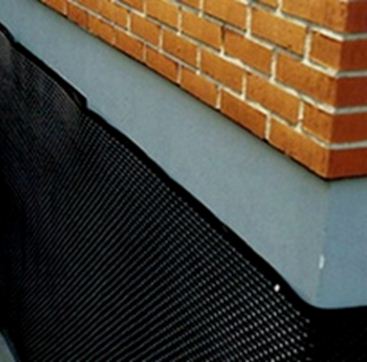
Armoring waterproofing
The physicochemical composition of mixtures for armor waterproofing differs in different ways.
To ensure longevity:
only the mineral elements that are included in the composition are used.
To ensure water resistance:
- the presence of a filler with a fine-grained structure;
- lack of impurities that dissolve in water: clay, silt and others;
- the use of high-quality waterproofing cements.
To ensure good strength of reinforced concrete elements and structures:
- use of aggregate of coarse-grained structure and only hard rocks;
- mandatory reinforcement.
The waterproofing mixture of armor action is used:
- for the manufacture of high-strength, waterproof monolithic concrete and reinforced concrete structures:
- underground and hydraulic structures;
- swimming pools;
- foundations, etc.
- during the repair and reconstruction of waterproofing elements:
- basement waterproofing;
- bathrooms and sanitary cabins;
- plinths;
- warm floors, etc.
Among the assortment of armor mixes, the following materials can be distinguished:
waterproofing mixture SII - intended for high-strength and waterproof plaster mortars, which are designed for a layer of plaster from 25 millimeters;
Dry mix hydro SII
waterproofing dry mix S + - intended for the manufacture of high-strength and waterproof plaster solutions, designed for a layer of plaster from 10 millimeters;
Dry mixes hydro S +, SW
mix-hydro 23 is a high-strength reinforced mix with the addition of fiber.
Dry waterproofing mixtures will ensure a long period of operation of the protective layer of various structures, structures and construction objects.
Dry mixes for waterproofing
The modern construction industry produces a complete set of waterproofing materials, with each cement material performing a specific function:
- Coating waterproofing
- Plaster waterproofing
- Suture waterproofing
- Repair mixtures
- Water plug
- Penetrating waterproofing
- Concrete admixtures
Lubricating waterproofing is used for waterproofing concrete, iron, foam, aerated concrete, as well as brick structures.
Waterproofing thickness 2-6 mm.
Waterproofing compounds are produced in two versions: rigid cement waterproofing (dry mix) and flexible polymer-cement waterproofing (two-component composition: dry mix + aqueous polymer dispersion).
Polymer-cement waterproofing is used for waterproofing structures with increased cracking, subject to thermal and mechanical deformation, settlement and vibration.
Plaster waterproofing - dry mixes for waterproofing concrete, reinforced concrete and brick structures when additional surface leveling is required.
Waterproofing thickness 5-50 mm.
Suture waterproofing - dry mixes for waterproofing joints, seams, junctions, abutments, communication inputs in statically loaded prefabricated and monolithic concrete structures.
Cement waterproofing of joints is not used in expansion joints and at variable peak loads, the values of which exceed its technical parameters, and is also not used on weakened and fragile substrates.
Repair mixtures are cement compositions using reinforcing fibers, which are used for local restoration of surfaces (chips, potholes, cracks, erosion) of concrete, iron, foam, aerated concrete, brick and stone structures.
Water plug - quick-setting (within a few minutes) cement compositions used for prompt elimination of pressure leaks through cracks, joints and holes in concrete and reinforced concrete structures, brick and masonry.
Penetrating waterproofing - dry mixes for waterproofing concrete and reinforced concrete structures (and more!).
This type of cement waterproofing is not intended for waterproofing foam concrete and aerated concrete structures (due to the large pore size), brick walls (due to the absence of substances necessary for the reaction in the brick).
The main difference between penetrating waterproofing and all other cement waterproofing: the formation of a waterproof coating not on the surface of concrete, but in its considerable thickness (the depth of penetration of active chemical components can
reach 10-12 cm).
Waterproofing additives in concrete - dry mixtures used as an additive in concrete at the stage of preparation, to increase water resistance, frost resistance and corrosion resistance of concrete and mortars.
The use of waterproofing additives reduces the number and volume of pores in concrete, thus increasing the density, strength, water resistance and durability of concrete.
Review of popular brands
Experts recommend purchasing dry mixes only from well-known brands and carefully studying the attached documentation, since there are too many counterfeit products on the market. Among the reputable manufacturers that have won the trust of buyers, the following brands can be distinguished:
Knauf
The most famous German manufacturer of various building mixtures. The range includes both cement-based and gypsum-based compounds.
For the organization of the screed, you can choose the cement mix "Ubo", which has improved thermal insulation properties. This was achieved through the use of expanded polystyrene granules. When using this filler, the resulting products are characterized by strength, increased heat and sound insulation properties.
Another line for the floor of the same brand is "Boden". It includes products with various numerical designations. For example, "Boden 15" is a composition for forming an ultra-thin layer with a thickness of 2-15 mm. "Boden 25" is cast in a thicker layer and allows leveling surface height differences up to 30 mm. When it is required to prepare a floor with large differences in height, the manufacturer suggests using the "Boden 30" mixture. With its help, it is possible to apply a layer up to 80 mm.
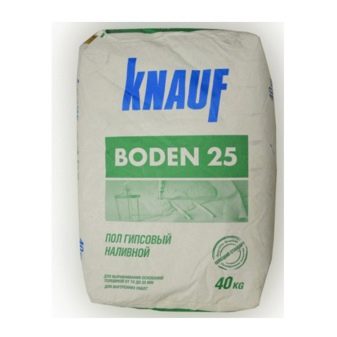
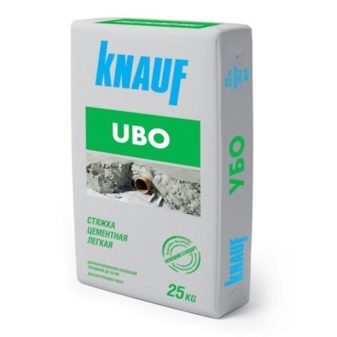
Ceresit
Several floor mixes are produced under this brand. For example, "Ceresit CN 80", which can be cast up to 80 mm thick. And you can walk on the flooded surface after 8 hours.
The product "Ceresit CN 808" is considered to be extremely durable and also features increased wear resistance. This allows it to be used inside and outside buildings, as well as to operate even without a topcoat.
The CN 175 screed, presented as a self-leveling mixture, is distinguished by its universal action. Fill thickness - up to 60 mm.
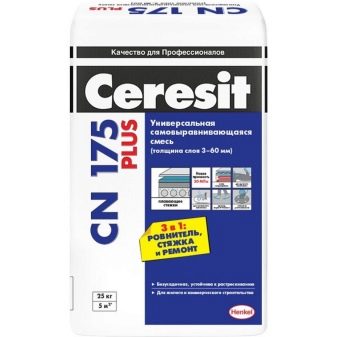

"Osnovit"
One of the leading domestic manufacturers of building mixtures. To fill the floor, you should purchase the compositions "Startoline 41" and "Mixline T-44". The first one is recommended for combination with warm floors. The second one can be applied with a thick (up to 150 mm) layer. This can be done manually or using special equipment.
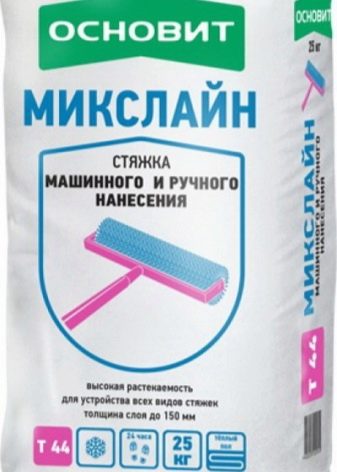
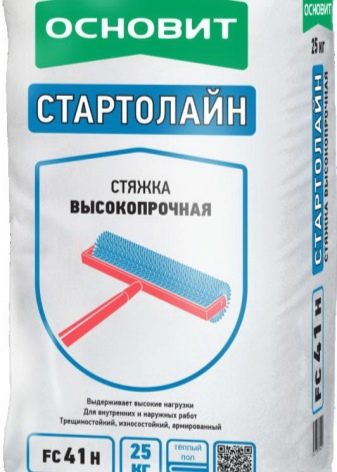
Volma
Russian manufacturer, whose history begins in the 1940s. Over the past period of its existence, the company has developed many unique formulas, special criteria for evaluating and controlling product quality. Floor mixes include 5 items. For a rough screed inside and outside the premises, "Volma Rovnitel rough" is produced from cement, lime and sand, with the addition of synthetic components and fiber fibers. Differs in increased strength, wear resistance, suitable for underfloor heating.
Volma Bulk Arena is also suitable for thick screeds, but it has greater fluidity. The scope of application of the "Volma Leveling Express" composition is exclusively indoor heated objects with normal humidity values. This is a gypsum-based mixture that is suitable for both rough and final pouring, and is also compatible with the "warm floor" system - it acts as a heat-accumulating screed.
"Volma Level Top" is used in cases where an ultra-thin screed is required, as well as increased operational loads, including high humidity, are expected. The coating thickness can be 3-20 mm.
"Volma Level Comfort" also allows you to achieve the thinnest possible screed. For indoor use only.
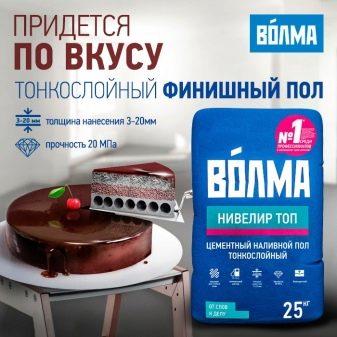

Instructions for the use of Ceresit CR 166 waterproofing:
Substrate preparation:
The substrate must be sufficiently strong, dense, even, absorbent and vapor-permeable.
The base must be cleaned of dirt (efflorescence, grease, oils, bitumen, etc.) and dust must be removed.
Unstable subfloors, peeling, paint coatings, lime plasters must be removed.
The age of concrete, cement-sand mortar, brick and masonry must be at least 28 days.
Clean loose and unfilled masonry joints to a depth of approx. 2 cm and fill with cement mortar or CT 24 or CT 29 repair mortar.
Substrates with irregular structures, e.g. brick-masonry, must be plastered with CT 24 or CT 29.
Fill cracks and fill with CX 5 mixture.
Fill holes and gaps in concrete with CN 83 repair mortar.
To stop water inflows, use a mixture of CX 1 or CX 5.
Fillets should be made in the corner zones (fillets with a radius of at least 3 cm from cement-sand mortar or mixtures of CX 5, CT 24, CT 29 or CN 83, and at the outer corners - make chamfers at an angle of 45 °.
Before applying the waterproofing mixture, the base must be moistened to saturation, avoiding the formation of drips and water accumulations.
Execution of works:
To prepare the waterproofing mass, the dry mixture (component A) is gradually added to the elasticizer (component B) with stirring, achieving a homogeneous mass without lumps.
Stirring is carried out with a mixer or a drill with a nozzle at a rotation speed of 400-800 rpm.
Then maintain a technological pause for about 5 minutes to ripen the mixture and mix again.
The mixture should be consumed within 1 hour from the moment of preparation.
The material is applied in 2 or 3 passes with a brush (preferably with a brush) with a layer of uniform thickness.
The next layers are applied in cross directions on the hardened, but still wet previous layer.
Under normal conditions, about 3 hours should elapse between coats.
Expansion and fillet joints in the absence of negative water pressure are recommended to be sealed with CL 52 tape, gluing it between the layers of waterproofing.
Tile facings can be fixed no earlier than 3 days after the application of the waterproofing compound using CM 16 Flex, CM 117 and CM 17 tile adhesives, or CM 11 Plus, CM 12 and CM 115 adhesives with the addition of CC 83 elasticizer.
After 7 days, the coating can take full hydraulic loads.
Fresh remains of the mass can be easily removed with water, dried ones can only be removed mechanically.
Recommendations for working with Ceresit CR 166 waterproofing:
Work should be carried out in dry conditions, at an air and base temperature from +5 to + 35 ° C and a relative air humidity not exceeding 80%.
Within 3 days after application, the material should be protected from drying out, rain, wind, direct sunlight and frost.
PACKAGE
You can buy Ceresit CR 166 waterproofing in a set of 2 packages with a total weight of 34 kg:
Component A (dry mix) in 24 kg multilayer paper bags.
Component B (polymer dispersion) in plastic cans of 10 kg
STORAGE
In dry conditions, on pallets, in original undamaged packaging, at temperatures from +5 to + 35 ° С (for liquid component B) - no more than 12 months from the date of production.
Protect from freezing !!!
Application and method of painting
It is necessary to prepare a dry building mixture and bring it into operation strictly according to the very recipe developed by the manufacturer. For work, you will need water heated to 70-80 degrees, the amount of liquid must be determined individually. Mixing requires the use of a cyclic or continuous apparatus. It is necessary to clearly separate the solutions into light and heavy groups. The film composition is designed to protect the main structure from the effects of water on the surface, penetrating works in its entire volume.
Manual mixing of the dry mix is quite possible, but using a special mixer is much more correct, it saves both time and effort. That is why professional builders always use just such equipment, which allows them to perform work quickly. At home, it is worth buying an electric drill with a stirrer (a special nozzle in the form of a whisk). The instrument must be taken after checking so that it is perfectly clean.
After waiting for the dust to settle, they begin to mix the composition at medium speed
It is very important to hold the drill or mixer firmly so that the tool does not pull out of your hands. In the process of mixing, it is allowed to add both water and new portions of the mixture, which allows you to vary its density and plastic qualities
For dry mixtures, water-based dye compositions are usually applied using rollers with long pile. To process corners and joints, you need to use paint brushes. You can adjust the color with a narrow brush. Painting work begins from the corner, and on the ceiling - from the junction with the wall, which falls on the corner farthest from the entrance.
Any water-based paint is applied in three layers:
-
parallel to the light from the window;
-
at right angles to it;
-
towards the window.
